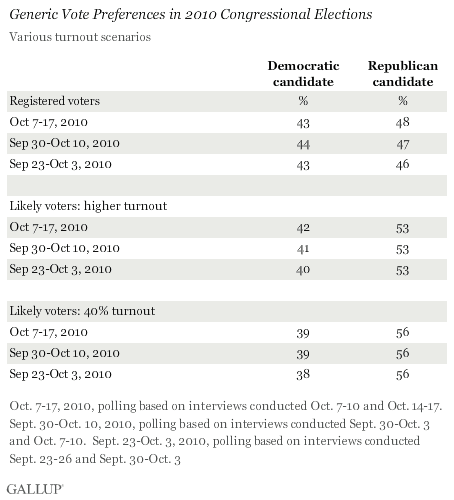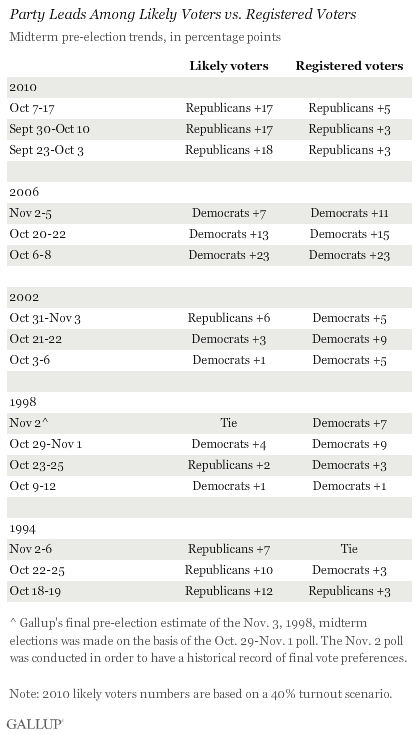PRINCETON, NJ -- Gallup's tracking of the generic ballot for Congress finds Republicans leading Democrats by 5 percentage points among registered voters, 48% to 43%, and by 11- and 17-point margins among likely voters, depending on turnout. This is the third consecutive week the Republicans have led on the measure among registered voters, after two weeks in September when the parties were about tied.

The latest results are from Gallup polling conducted the past two weekends, Oct. 7-10 and Oct. 14-17, and based on interviews with more than 2,700 registered voters and more than 1,900 likely voters.
For Republicans to lead, or even be at parity with Democrats, on the generic congressional ballot indicates they are in a good position to win a majority of House seats in the upcoming elections. This is because of Republicans' typical advantage in voter turnout, which in recent years has given that party an average five-point boost in support on Election Day.
If the elections were held today and roughly 40% of voters turned out -- a rate typical in recent years -- Gallup's Oct. 7-17 polling suggests Republicans would win 56% of the vote -- 8 points greater than their support from registered voters, and 17 points ahead of Democrats, at 39%. If turnout is significantly higher, Republicans would receive 53% of the vote (a 5-point improvement over their registered-voter figure), and the Democrats, 42%.
The likely voter estimates at both turnout levels have been consistent over the past three weeks.

History Offers Mixed Picture of Stability of Voter Preferences in October
With the elections now only two weeks away, the key questions relating to the outcome are whether voters might still change their minds about which party to support, and whether Democrats' motivation to vote will yet surge, enabling that party to narrow the gap among likely voters.
Gallup polling from the prior four midterm elections shows that significant movement can, but does not always, occur in the final month before Election Day. This was most pronounced in 2006, when the Democrats' 23-point early October leads among both registered and likely voters dwindled to 11-point and 7-point leads, respectively, by the final pre-election week.
In early October 2002, the Democrats led by five points among registered voters and by one point among likely voters. In the final poll, they maintained a five-point lead among registered voters, but trailed Republicans by six points among likely voters -- marking a seven-point swing in the race.
In the year that perhaps most closely parallels today, 1994, the Republicans led the Democrats in mid-October polling by 3 points among registered voters, and by 12 points among likely voters. In the end, the Republicans tied the Democrats among registered voters and led by 7 points among likely voters.

Bottom Line
U.S. voters' preferences for the party they will support in this year's House elections have been quite stable over the past three weeks, with Republicans leading by low single digits among registered voters. They lead by substantially more than that among likely voters, including both high-turnout and typical-turnout scenarios.
It is not clear from the historical record how likely these patterns are to continue through the end of the month. Gallup's pre-election polling in prior midterm years documents that there were some years when the structure of voter preferences by this point in October was generally maintained through the elections (1998 and, to a lesser extent, 1994), but others when it changed substantially (2002 and 2006).
Learn more about Gallup's likely voter models for the 2010 midterm congressional elections.
Results for this Gallup poll are based on telephone interviews conducted Oct. 7-10, 2010, and Oct. 14-17, 2010, with a random sample of 3,051 adults, aged 18 and older, living in the continental U.S., selected using random-digit-dial sampling.
For results based on the total sample of national adults one can say with 95% confidence that the maximum margin of sampling error is ±2 percentage points.
For results based on the total sample of 2,731 registered voters, one can say with 95% confidence that the maximum margin of sampling error is ±2 percentage points.
Results for likely voters are based on a sample of 1,951 survey respondents deemed most likely to vote in the November 2010 General Election, according to a series of questions measuring current voting intentions and past voting behavior. For results based on the sample of likely voters, the maximum margin of sampling error is ±3 percentage points. Gallup provides two likely voter estimates using this sample. The lower turnout estimate assumes 40% national adult turnout and applies additional weights within the broad likely voter sample to match this turnout assumption. The higher turnout estimate gives all likely voters the same weight and represents a turnout level of 55% of national adults.
Interviews are conducted with respondents on landline telephones (for respondents with a landline telephone) and cellular phones (for respondents who are cell phone-only). Each sample includes a minimum quota of 150 cell phone-only respondents and 850 landline respondents, with additional minimum quotas among landline respondents for gender within region. Landline respondents are chosen at random within each household on the basis of which member had the most recent birthday.
Samples are weighted by gender, age, race, education, region, and phone lines. Demographic weighting targets are based on the March 2009 Current Population Survey figures for the aged 18 and older non-institutionalized population living in continental U.S. telephone households. All reported margins of sampling error include the computed design effects for weighting and sample design.
In addition to sampling error, question wording and practical difficulties in conducting surveys can introduce error or bias into the findings of public opinion polls.
View methodology, full question results, and trend data.
For more details on Gallup's polling methodology, visit www.gallup.com.
